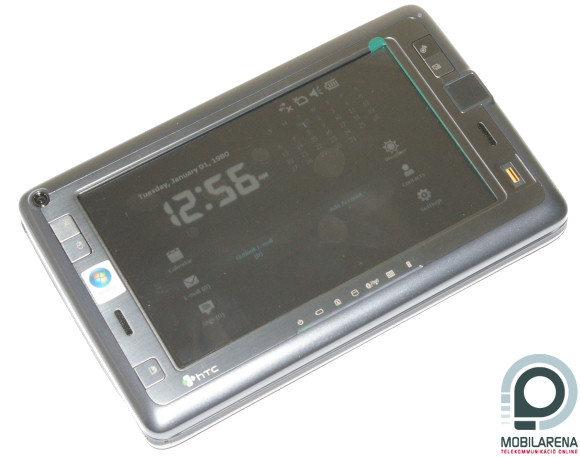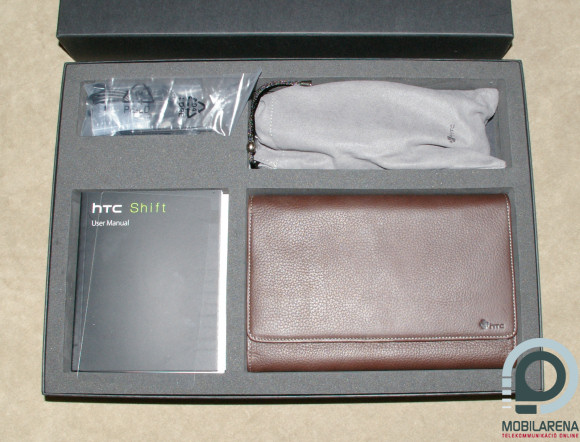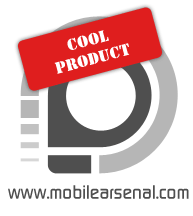What’s this?
If someone takes a look at HTC’s site these days, then he will find two devices under the Mobile Computer category, Advantage and Shift. This might confuse some, since while the first is a large Pocket PC, the latter is a UMPC. Although things are not that simple, due mainly to the lot of false information that were circling around before the device appeared.

Shift is not an everyday UMPC. We could say that it’s an innovative invention, but I will tell you only later how innovative is it. The main thing is that HTC wanted to put two different device types (that are hard to define even on their own) together: a UMPC and a PDA. As we know the first stands for Ultra Mobile PC, while the latter is the naming for Personal Digital Assistants, that is devices that run Windows Mobile for Pocket PC as an operating system. PDAs can be though of as computers with limited functions that are incompatible with the platform running on desktop PCs and UMPCs. It’s possible that many of you ask that what is the meaning of putting these two together, considering that due to their incompatibility they need separate hardware. The answer is logical: online time.

Although the handset is on the market since last fall/winter, but not even a sample has been available in our country, so we were very happy for the one provided by XXL PC as we have been one of the first to test the special machine in the country. Even taking over the device was a real adventure, as I have received such a box that could hold my bag (which is large enough on its own) at least three times – so the transportation was done with a plastic bag; a large one by the way. After taking off the gray cover I found a huge decoration box, which contained a large leather case, a stereo headset, a USB hub with 3 ports, a display protection foil, a backup stylus and a charger made of two parts (in a textile bag) besides the device. And all of these were shipped with the usual HTC garnish, so unpacking was a real experience.
Exterior
The machine itself wasn’t such a shock, as I have already taken one of these in my hands at Mobile World Congress and I wasn’t all that excited about it. It weighs exactly 800 grams and has a size of 207 x 129 x 25 mm, so it’s not small; as a matter of fact it’s much larger than other UMPCs I have seen. As a reason we could mention the double-hardware and the QWERTY keyboard (which looks really nice at first), but no matter these, Shift still is large, at least from my point of view.

The use of materials is basically good, but for this sum I would expect my device not to be completely made of plastic, as unfortunately it is of plastic. The reason for not using any metal might be that they didn’t want to launch a device weighing more than 1 kg, so let’s be positive and happy about the plastic cover. Of course the designers at HTC are tricky: the frame around the 7”, 800 x 480 pixel large display looks like metal, but it’s not – this is only deception. The display is a high quality one, by the way, but for such a physical size I think a higher resolution should have been used.

There is lots of stuff around the TFT panel. In the top left corner there us the VGA camera, under this there are the two mouse buttons, the Vista sticker, a speaker and the button for changing between the two operating systems – details later. On the bottom we can find the armada of status LEDs, on the right there are again two buttons (a hotkey and a resolution changer), on the bottom there is the mouse replacement called microPAD, which is a really hard to use part, I have seen only better solutions. It’s not over yet, as the other speaker and the fingerprint reader are all on this side, the latter being a really useful gadget. There is nothing on the top part.

In the four corners on the back there are rubber pads, the device is laid on these when put on the table. The lower part is detachable, this covers the 2700 mAh battery, and this is where we can find the socket of the SIM card too. On top and on the sides there are air vents – there is a cooler behind the upper one, which pushes out hot air quite fast – and loud – when the device is actively used.

After sliding the device, the QWERTY keyboard is revealed. The sliding process requires quite an effort, which is promising for device lifetime. The keyboard seems really pleasant at first glance, but its use is hardened by the lack of backlight and because keys are much smaller than on a standard notebook, which makes typing a not so comfortable process on Shift. Typing is overall impossible when holding the handset in our hands, because of two reasons: on one hand the keyboard is too large to reach every key with our thumbs and on the other hand the device’s center of mass is around the display, so the device has to be held forcefully in order to not to drop it.

The situation improves much when Shift is on a table, as we can turn it up, like on the picture. The mechanical part is great, turning up needs some effort too, as the upper part is held horizontally by a security lock.

The 3.5 mm jack output is on the left side, the built-in microphone is also on this side. The telescopic stylus is between these two; this is also locked in its place, we have to push its tip in order to get it out – it’s something like the system used at memory cards.

On top we can only find a 15-pin D-Sub connector; this is where we can attach a monitor or a projector. On the right there is the connector of the charger, the one and only USB port (output or Host), the keypad locking slider that also functions as the power button and the SD card socket. As I have previously written it, there is a USB hub amongst the accessories, which can be used to connect up to three devices to the machine. A D-Sub -> DVI converter should have also been included in the box, there probably would have been enough room.

Hardware
In means of hardware we have to split the machine in two: there is the environment used for running Vista and there is a PDA hardware, which runs SnapVUE, based on Windows Mobile (or at least on Windows CE kernel). The first configuration uses an 800 MHz Intel A110 CPU, which has 1 GB microDIMM DDR2 memory as a companion. Storage is provided by a 1.8” hard disk, which is 40 or 60 GB large. The sample I had for testing was using the smaller edition.

SnapVUE is theoretically running on a 400 MHz Qualcomm CPU, although this is not mentioned in the specs from the manufacturer’s site. The capacity of program memory is 64 MB, while storage space is 128 MB large, as SnapVUE can not access the hard disk – energy saving is the most probable reason for this. Considering the functions of the system, this memory is more then enough; I will tell you why on the next page.

There is a fair number of data transfer protocols supported. The SIM socket tells us that Shift has a HSDPA modem, which makes possible the use of a theoretical maximum speed of 3.6 Mbps on suitable 3.5G networks. In case there is no network coverage, we can fall back to UMTS, EDGE, or GPRS. The SIM card is used only for data transfer, which means that Shift cannot be used to make phone calls (of course we can install Skype). Above all these mentioned, there is 802.11b/g WiFi and 2.0 Bluetooth support too, all working perfectly under Vista, but SnapVUE doesn’t support WiFi, it can only fetch our mail using a mobile internet network.
PDA mode - SnapVUE
The "PDA-mode" expression used as page title is quite an exaggeration, as contrary to previous rumors, the device doesn’t have Windows Mobile as an operating system. It is based on that, however, as the system called SnapVUE looks very much like a WM system running TouchFLO at first glance – there is one small thing missing, which is the Start button.

Unfortunately due to this deficiency we have to give such things like software expandability. To make myself more understandable: we cannot install Windows Mobile software on Shift. Practically SnapVUe is only a “status-watching” system; we can use it to look at the time, at weather, we can send and receive emails and SMS messages, we can see upcoming calendar events and write new ones, we can set an alarm clock and take a look at the contact list. That’s all…

..but it could be more. More and more Shift owners are working on making Windows Mobile 6 installable on the device. Why? Well, because some applications would come in handy; for example a movie player (TCPMP), a web browser (like Opera for Pocket PC) and the possibility itself to be able to install software. SnapVUE, by the way, cannot access either WiFi or the SD card, so quite a lot of things block us in using it this way. Reading these lines many of you might ask: why do I want to surf the net with a VGA resolution Pocket PC browser if I can switch to Vista with the press of a button? Again, online time is the keyword: according to factory data, the device can only run the aforementioned system for only two hours, while SnapVUE takes it much longer. This makes me think. Which is better: surf the net for two hours with Firefox, or for 6-8 hours with Opera for Pocket PC?
UMPC mode - Vista
I must make it clear in advance that I won’t be writing much about this part, as I am not testing Vista itself. Furthermore, to tell the truth, I didn’t really use this system on a desktop computer either, which puts me in trouble judging the speed. What is sure, is that the Vista Business on this device doesn’t run as fast as on a fairly good desktop PC, but this can in no way be expected from a UMPC.

We can find the following extra applications on the handset: Vitakey (for the fingerprint reader), Tablet PC, Shift Control Center, Microsoft Origami Experience 2.0, and Communication Manager from HTC. Vista gave the following “experience points” (muhaha) for the machine:
| Vista ratings | ||
| CPU | 2.1 | |
| RAM | 4.5 | |
| Vista Graphics for Aero | 3.8 | |
| Gaming Graphics | 2.7 | |
| Disk | 3.5 | |
Just as it name tells, Communication Manager handles all kinds of data communication activities and this is where we can set brightness too, for example. We can access it quickly with the button on the right, but the software itself is nothing really stable: it hung up lots of times and produced other interesting errors too. For example it happened to me that I have turned WiFi on, and then changed to SnapVUE, which made the whole device to hang up. In such a case the only thing that helped was to remove and put back the battery.


Conclusion
Let’s mention the battery and online time in a few words before the conclusion. Vista can theoretically run for 2 hours with one charge – I can only confirm this value, what more, this was achieved during browsing the web through WiFi. SnapVUE of course takes much more; it was online for two days (!), while it was continuously checking my email.

I think this answers the big question of what SnapVue is good for. Well it’s good because we can perform regular, frequent tasks (new SMS-e-mail, calendar entry, time, weather forecast) without consuming too much battery power. The idea is good, but it would be even better if it would be running Windows Mobile 6, as rumored, as we could be watching movies, listening to music, browsing the web for a longer time that way – moreover, with the exception of web browsing I’m not sure that we would have a user experience inferior to the one provided by Vista. Of course those who buy such a machine are not sure that want to listen to music on it, not even with these exceptional quality speakers, but it would still be good to have the possibility of installing TCPMP.
Unfortunately the list of negative aspects is longer than I would have expected: poor online time under Vista, keyboard without a backlight, hard to use touchpad-mouse, HTC Communication Manager freezes a lot and of course there is the non-expandable SnapVUE system. On a whole, the machine is usable, but I think this SnapVUE is not worth this much, I’d rather choose a UMPC with better online time, than Shift. However the idea deserves an award.
 |
| HTC Shift |
Bocha
HTC Shift was provided by XXL PC.
The device can be bought at:
Budapest VI. Jókai tér 6.
Budapest VI. Teréz körút 18.
On-line at www.xxlpc.hu.
Specifications
| HTC Shift (X9500) | ||
 | ||
| Operating system | Windows Vista Business | |
| Processor | 800 MHz Intel A110 (Vista) 400 MHz Qualcomm MSM7200 (SnapVUE) | |
| Display | 7” WVGA (800 x 480 pixel) touchscreen | |
| Memory | 1 GB DDR2 (Vista) 64 MB RAM + 128 MB ROM (SnapVUE) | |
| Hard disk | 1.8” , 40/60 GB (4200 rpm) | |
| Sound | 3.5 mm jack output, microphone, stereo speakers | |
| Optical drive | none | |
| Communication | HSDPA/UMTS/EDGE/GPRS 802.11b/g WiFi Bluetooth 2.0 | |
| Connectors | 1 x 3.5 mm jack output 1 x D-Sub 1 x USB 2.0 (Host) 1 x charger connector | |
| Extras | SnapVUE status display system fingerprint reader QWERTY keyboard optical touchpad-mouse | |
| Webcam | VGA resolution CMOS, fixed focus | |
| Battery | 2700 mAh, changeable | |
| Size | 207 x 129 x 25 mm | |
| Weight | 800 grams | |
| Online time | 2 hours of active use with Vista 53 hours standby time with push e-mail turned on (SnapVUE) 10 days standby time with push e-mail turned off (SnapVUE) | |









